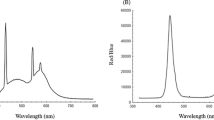Summary
The relationships between rosette size, vernalization, and photoperiod in bolting induction of Oenothera erythrosepala (a facultative biennial) were examined. A natural population of O. erythrosepala in a sand dune system at Azigaura, Japan, behaves as a monocarpic perennial, while a population treated with fertilizer showed the life cycle of a winter annual. In both natural and fertilized populations, bolting was restricted to size classes with rosette diameter greater than 9 cm, regardless of the chronological age and the amount of food reserves accumulated in the tap root. Pot culture experiments showed that the species requires both vernalization and long-day photoperiod for bolting induction, and has a critical leaf area for receiving photoperiodic stimuli. The amount of food reserves in the plant per se does not contribute to the size-dependent flowering of the species.
Similar content being viewed by others
References
Baskin JM, Baskin CC (1979a) Studies on the autecology and population biology of the weedy monocarpic perennial, Pastinaca sativa. J Ecol 67:601–610
Baskin JM, Baskin CC (1979b) Studies on the autecology and population biology of the monocarpic perennial Grindelia lanceolata. Am Midl Nat 102:290–299
Epstein E (1972) Mineral nutrition of plants: Principles and perspectives. Wiley, New York
Grime JP (1979) Plant strategies and vegetation processes. John Wiley & Sons, Chichester
Gross, KL (1981) Prediction of fate from rosette size in four “biennial” plant species: Verbascum thapsus, Oenothera biennis, Daucus carota, and Tragopogon dubius. Oecologia (Berlin) 48:209–213
Hackett WP, Hartmann HT (1964) Inflorescence formation in olive as influenced by low temperature, photoperiod, and leaf area. Bot Gaz 125:65–72
Harper JL (1977) Population biology of plants. Academic Press, London
Harper JL, Ogden J (1970) The reproductive strategy of higher plants. J Ecol 58:681–698
Hirose T (1983) A graphical analysis of life history evolution in biennial plants. Bot Mag (Tokyo) 96:37–47
Hirose T, Kachi N (1982) Critical plant size for flowering in biennials with special reference to their distribution in a sand dune system. Oecologia (Berlin) 55:281–284
Kachi N (1983) Population dynamics and life history strategy of Oenothera erythrosepala in a sand dune system. Dr thesis University of Tokyo
Kachi N, Hirose T (1979) Multivariate approaches to the plant communities related with edaphic factors in the dune system at Azigaura, Ibaraki Pref, I. Association-analysis. Jap J Ecol 29:17–27
Kawano S (1975) The productive and reproductive biology of flowering plants. II. The concept of life history strategy in plants. J Coll Lib Arts, Toyama Univ 8:51–86
Lang A (1965) Physiology of flowering initiation. In: Rühland W (ed) Encyclopedia of plant physiology, vol 15 (part 1). Springer, Berlin, p 1380–1536
Levin DA (1973) The age structure of a hybrid swarm in Liatris (Compositae). Evolution 27:532–535
Lewontin RC (1965) Selection for colonizing ability. In: HG Baker, GH Stebbins (eds), The genetics of colonizing species. Academic Press, New York pp 77–94
Meijden E van der, Waals-Kooi RE van der (1979) The population ecology of Senecio jacobaea in a sand dune system. I. Reproductive strategy and the biennial habit. J Ecol 67:131–153
Osada T (1976) Coloured illustrations of naturalized plants of Japan. Hoikusha, Osaka (in Japanese)
Peterson DL, Bazzaz FA (1978) Life cycle characteristics of Aster pilosus in early succesional habitats. Ecology 59:1005–1013
Rünger W (1971) Blütenbildung und Blütenentwicklung. Verlag Paul Parey, Berlin
Schwabe WW (1954) Factors controlling flowering in the Chrysanthemum. IV. The site of vernalization and translocation of the stimulus. J Exp Bot 5:389–400
Shokyu N, Ohashi H (1972) Cultivation and breeding of Oenothera-plant. I. Geographical variation of Oenothera-plant. Shoyakugaku Zasshi 26:25–35 (in Japanese with English summary)
Werner PA (1975) Prediction of fate from rosette size in teasel (Dipsacus fullonum L.). Oecologia (Berlin) 20:197–201
Yokoi Y (1976) Growth and reproduction in higher plants II. Analytical study of growth and reproduction of Erythronium japonicum. Bot Mag (Tokyo) 89:15–31
Author information
Authors and Affiliations
Rights and permissions
About this article
Cite this article
Kachi, N., Hirose, T. Bolting induction in Oenothera erythrosepala Borbás in relation to rosette size, vernalization, and photoperiod. Oecologia 60, 6–9 (1983). https://doi.org/10.1007/BF00379312
Received:
Issue Date:
DOI: https://doi.org/10.1007/BF00379312




